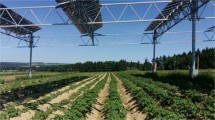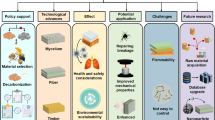Abstract
In recent years, green roofs have become the subject of increasing interest because of their good aesthetic qualities, energy conservation, and ability to reduce thermal island effect and absorb greenhouse gases, especially carbon dioxide (CO2). Given the typically significant carbon emission of construction activities, adding any extra component to a structure increases the amount of carbon to be released during the execution stage. This also applies to green roofs, which require more materials and more extensive construction activities than traditional roofs. However, plants of green roofs absorb substantial amounts of CO2 during their lifetime, thus leaving both short- and long-term positive impacts on the building’s carbon footprint. This study investigated the short- and long-term effects of green roofs on carbon footprint, as compared to conventional roofs. For this investigation, the CO2 uptake of eight plant species with suitable drought- and cold-resistant properties was measured by infrared gas analysis (IRGA), and the effect of green roof on the building’s carbon footprint was analyzed using the software Design Builder. The results showed that building a green roof instead of a traditional roof increases the carbon emission of the construction process by 4.6 kg/m2 of roof area. Investigations showed that, under high light intensities (1500–2000 μmol/m2 s), Sedum acre L. has the best performance in compensating the extra carbon emission imposed on the construction process (in 264 days only). Under low light intensities (1000–1500 μmol/m2 s), Frankenia laevis showed the best increase in the amount of carbon uptake (2.27 kg/m2 year).





Similar content being viewed by others
Data availability
All data generated or analyzed during this study are included in this published article
References
Bird, R., 2004. Knowing and growing annuals and perennials, an illustrated encyclopedia and complete practical gardening guide. Select Editions.
Carter T, Jackson CR (2007) Vegetated roofs for stormwater management at multiple spatial scales. Landscape Urban Plan. 80:84–94
Chen J, Shen L, Shi Q, Hong J, Ochoa JJ (2019) The effect of production structure on the total CO2 emissions intensity in the Chinese construction industry. J Clean Prod. 213:1087–1095
Cole RJ (1998) Energy and greenhouse gas emissions associated with the construction of alternative structural systems. Build Environ. 34(3):335–348
Collazo-Ortega, M., Rosas, U., Reyes-Santiago, J., 2017. Towards providing solutions to the air quality crisis in the Mexico city metropolitan area: carbon sequestration by succulent species in green roofs. PLoS Curr. 9.
EPA. 2018. Inventory of U.S. greenhouse gas emissions and sinks: 1990–2016.
Fenner AE, Kibert CJ, Woo J, Morque S, Razkenari M, Hakim H, Lu X (2018) The carbon footprint of buildings: a review of methodologies and applications. Renew Sust Energ Rev. 94:1142–1152
Gamarra A, Istrate I, Herrera I, Lago C, Lizana J, Lechón Y (2018) Energy and water consumption and carbon footprint of school buildings in hot climate conditions. Results from life cycle assessment. J Clean Prod. 195:1326–1337
Getter KL, Rowe DB, Robertson GP, Cregg BM, Andresen JA (2009) Carbon sequestration potential of extensive green roofs. Environ Sci Technol. 43(19):7564–7570
González MJ, Navarro JG (2006) Assessment of the decrease of CO2 emissions in the construction field through the selection of materials: practical case study of three houses of low environmental impact. Build Environ. 41(7):902–909
Guo WJ, Lee N (2006) Effect of leaf and plant age, and day/night temperature on net CO2 uptake in Phalaenopsis amabilis var. Formosa. J Am Soc Hortic Sci. 131(3):320–326
Huang W, Li F, Cui Sh, Huang L, Lin J (2017) Carbon footprint and carbon emission reduction of urban buildings: a case in Xiamen City. China. Procedia Engineer. 198:1007–1017
Iran Meteorological Organization, 2019. Daily temperature and precipitation reports. http://www.irimo.ir
Jeong YS, Lee SE, Huh JH (2012) Estimation of CO2 emission of apartment buildings due to major construction materials in the Republic of Korea. Energ Buildings. 49:437–442
La Roche P, Berardi U (2014) Comfort and energy savings with active green roofs. Energ Buildings. 82:492–504
Li WC, Yeung KKA (2014) A comprehensive study of green roof performance from environmental perspective. Int J Sust Built Environ. 3(1):127–134
Li Jf, Wei OWH, Li YS, Zhan J, Ho YA, Li J, Lam E (2010) Effect of green roof on ambient CO2 concentration. Build Environ. 45(12):2644–2651
Ministry of Roads and Urban Development of Iran, 2019. Building Reports & Statistics, https://www.mrud.ir/
Mirzababaie MJ, Karrabi M (2019) Implementing green roof technology: an investigation of the effects on energy demand, fuel consumption, and pollutant emission. Clean Technol Envir. 21(9):1873–1881
Nadoushani ZSM, Akbarnezhad A (2015) Effects of structural system on the life cycle carbon footprint of buildings. Energ Buildings. 102:337–346
Ondoño S, Martínez-Sánchez J, Moreno J (2016) The composition and depth of green roof substrates affect the growth of Silene vulgaris and Lagurus ovatus species and the C and N sequestration under two irrigation conditions. J Environ Manage. 166:330–340
Peck S, Kuhn M (2003) Design guidelines for green roofs. Ontario Association of Architects, Canada https://www.cmhc-schl.gc.ca/en
Rickard S (2011) The New Ornamental Garden. Csiro Publishing
Sailor DJ (2008) A green roof model for building energy simulation programs. Energ Buildings. 40(8):1466–1478
Silva CM, Flores-Colen I, Coelho A (2015) Green roofs in Mediterranean areas–survey and maintenance planning. Build Environ. 94:131–143
Statistical Center of Iran, (2018). Building Reports & Statistics, https://www.amar.org.ir/
Takebayashi H, Moriyama M (2007) Surface heat budget on green roof and high reflection roof for mitigation of urban heat island. Build Environ. 42(8):2971–2979
Umemiya C, Ikeda M, White MK (2020) Lessons learned for future transparency capacity building under the Paris Agreement: a review of greenhouse gas inventory capacity building projects in Viet Nam and Cambodia. J Clean Prod. 245:118881
Weinstein G (1999) Xeriscape hand book: a how-to guide to natural, resources-wise gardening. Fulcrun Publication, Colorado
Whittinghill LJ, Rowe DB, Schutzki R, Cregg BM (2014) Quantifying carbon sequestration of various green roof and ornamental landscape systems. Landscape Urban Plan. 123:41–48
Xu G, Schwarz P, Yang H (2019) Determining China’s CO2 emissions peak with a dynamic nonlinear artificial neural network approach and scenario analysis. Energ Policy. 128:752–762
Yang X, Hu M, Wu J, Zhao B (2018)Building-information-modeling enabled life cycle assessment, a case study on carbon footprint accounting for a residential building in China. J Clean Prod. 183:729–743
Yin K, Zhao Q, Li X, Cui S, Hua L, Lin T (2010) A new carbon and oxygen balance model based on ecological service of urban vegetation. Chinese Geogr Sci. 20(2):144–151
Acknowledgements
We would like to show our gratitude to Professor Jorge de Brito for sharing his ideas and comments with us during the course of this research.
Funding
This research study was conducted with the support of the Vice Chancellor of Research of the Ferdowsi University of Mashhad through grant number 52192.
Author information
Authors and Affiliations
Contributions
MK and JN devised the project, the main conceptual ideas, and proof outline. MRS carried out the experiment and simulations. MK supervised the findings of this work. All authors discussed the results and contributed to the final manuscript.
Corresponding author
Ethics declarations
Ethics approval
Not applicable
Consent to participate
Not applicable
Consent for publication
Not applicable
Competing interests
The authors declare no competing interests.
Additional information
Responsible Editor: Philippe Garrigues
Publisher’s note
Springer Nature remains neutral with regard to jurisdictional claims in published maps and institutional affiliations.
Rights and permissions
About this article
Cite this article
Seyedabadi, M.R., Karrabi, M. & Nabati, J. Investigating green roofs’ CO2 sequestration with cold- and drought-tolerant plants (a short- and long-term carbon footprint view). Environ Sci Pollut Res 29, 14121–14130 (2022). https://doi.org/10.1007/s11356-021-16750-w
Received:
Accepted:
Published:
Issue Date:
DOI: https://doi.org/10.1007/s11356-021-16750-w




